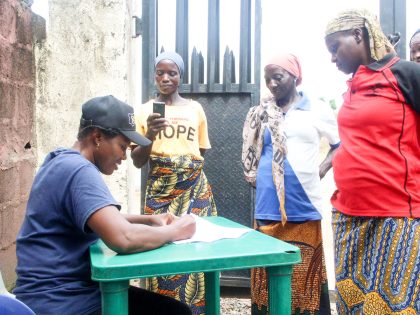One Percent Feminism
Neoliberalism's model of social justice: the rich prosper, but an appropriate percentage of them are minorities or women.

Christine Lagarde at the World Economic Forum in 2013. Image via Wikimedia Commons.
This past January’s World Economic Forum — the annual shindig of the world’s super rich and their acolytes — garnered attention for being co-chaired entirely by women for the first time in its forty-seven year history. The organizers obviously hoped this would begin to address gender inequality at a conference where women comprised only twenty-one percent of attendees. But before we celebrate, it is worth taking in critical theorist Nancy Fraser’s injunction that this sort of female representation is a superficial detraction; it “embodies a neoliberal kind of feminism which mostly benefits privileged women.”
Literary theorist Walter Benn Michaels articulated the link between one percent feminism and neoliberalism concisely:
It’s basically OK if economic differences widen as long as the increasingly successful elites come to look like the increasingly unsuccessful non-elites. So, the model of social justice is not that the rich don’t make as much and the poor make more, the model of social justice is that the rich make whatever they make, but an appropriate percentage of them are minorities or women.”
Christine Lagarde, the female head of the International Monetary Fund, presided over the event. Lagarde tried to be clever: this is a “panel, not a manel,” she quipped during the introductory session.
Hillary Clinton’s loss in the US presidential elections in 2016 brought her feminist record under scrutiny. She famously remarked at a UN conference in 1995 that human rights are women’s rights and women’s rights are human rights once and for all. Yet, her support for access to birth control and abortions falls short of holistic approaches in other developed democracies that include childcare and paternity leave. In 1996, as US First Lady, Clinton supported a welfare reform bill that made daily life precarious for low-income American women. As secretary of state under Barack Obama, Clinton’s hawkish foreign policy stance aligned with neoconservatives such as Robert Kagan. She strongly supported the war in Iraq which produced grave physical and economic insecurities for a generation of Iraqi women. United States intervention in the Middle East precipitated its destabilization, and ultimately triggered the xenophobic backlash that has boosted conservatism and renewed the urgency to fight for women’s equality in the United States.
One year after the historic Women’s March in Washington, D.C., some Clinton supporters, who flooded the streets in a sea of pink knit hats, are reconsidering these objects as unserious symbols of an activism not fit for these times. In her memoir What Happened, Clinton cast blame on a disaffected young woman for failing to vote in the 2016 election. Since then, Clinton has rebuffed criticism for her close relationship with serial predator Harvey Weinstein, and for protecting a campaign advisor accused of sexual harassment, and has receded from the public eye.
Liberal feminism asserts that the duty to advance feminism calls for individuals to modify their behaviors and expectations, such as by “leaning in,” coined by Facebook COO Sheryl Sandberg. Sandberg has partnered with other powerful women—former Secretary of State Condoleezza Rice, and Anna Maria Chavez of the Girl Scouts—to spread the message of female self-empowerment. Yet, promoting women into positions of power and on boards of directors aligns with corporate goals and enhances companies’ bottom line. On the other hand, cooperation among working class women often begins inside a workplace with no support to “lean in” to, at great personal risk.
So, who were the three co-chairs of the WEF and what are their politics?
Most prominent among the seven co-chairs, were Ginny Rometty, CEO of IBM, Prime Minister of Norway Erna Solberg, and Managing Director of the IMF, Christine Lagarde.
Ginny Rometty became the first female CEO of IBM in 2011. She has defended herself against critics for advising Trump after the disbanding of his Strategic and Policy Forum, when he blamed “both sides” of a white supremacist attack in Charlottesville, VA. Under Rometty’s leadership, IBM has seen the number of jobs offshored rise to 130,000, or one third of all IBM jobs, to India where salaries are a fraction of US salaries.
Rometty has championed IBM’s AI known as Watson, as a tool for national security, in a security culture that increasingly targets majority Muslim countries and communities within the United States. Some have drawn parallels between Trump’s previous calls for a Muslim registry with a dark moment in IBM’s past, when its first CEO, Thomas J. Watson, provided Hitler’s Nazi regime with technology to compile machine-tabulated census data in 1933.
In her role as managing director of the IMF, Christine Lagarde “looks under the skin of countries’ economies” to diagnose them. She has called upon leaders to promote women’s equality, yet the IMF has historically pursued measures that push countries to adopt austerity measures which disproportionately affect women. Feminist economists protested the imposition of austerity in Greece, where a study found it to be driving women into prostitution. Although the IMF has since examined its policies in this area, Lagarde has recently backed away from a plan to further alleviate Greece’s debt crisis.
Norwegian Prime Minister Erna Solberg, is the second ever female Prime Minister of Norway since 2013 and leader of the center-right, Conservative Party since May 2004. Solberg’s coalition government includes the “neoliberal populist” Progress Party, which gained support for its anti-immigration stance amid the global migration crisis, and her tenure has brought policies of economic liberalism, tax reductions and promotion of public-private partnerships. Yet, whereas Hillary Clinton invoked the rhetoric of women’s empowerment as First Lady, to support the dismantling of the US welfare state, Solberg’s government continues to promote gender equality through policy initiatives and a robust safety net.
The closing plenary of the 2018 World Economic Forum highlighted the vast gulf between one percent feminists and the millions of men and women who lack basic human rights that they purport to care about. Among the panel of artists, famed British portrait photographer Platon Antoniou shared the photograph of a woman from the Democratic Republic of the Congo, where rape has become a tool of warfare in resource conflicts fueled by primarily Western consumption of minerals used in product manufacture.
“I’d like you to look at Sandra. Isn’t she beautiful? Sandra was raped with extreme violence,” he began, reminding his carefully listening audience that, “we are all strangely connected to this problem.”
The role of art is critical at disjunctive times like these. Sandra, the survivor, recognizing an opportunity to have her message carried to a room in which multiple individuals possessed more wealth than the total GDP of her country in 2017, called on Antoniou specifically to deliver her message. As long as global capitalist systems, some of which may be led by all-female boards of directors, perpetuate extreme inequality, mainstream feminism will not break down the connections that built the Davos men and women. Still, the artist implored his audience: “There is a moral battle raging out there, and we have to do something about it by closing the empathy gap.”
Light applause filled the room.



















